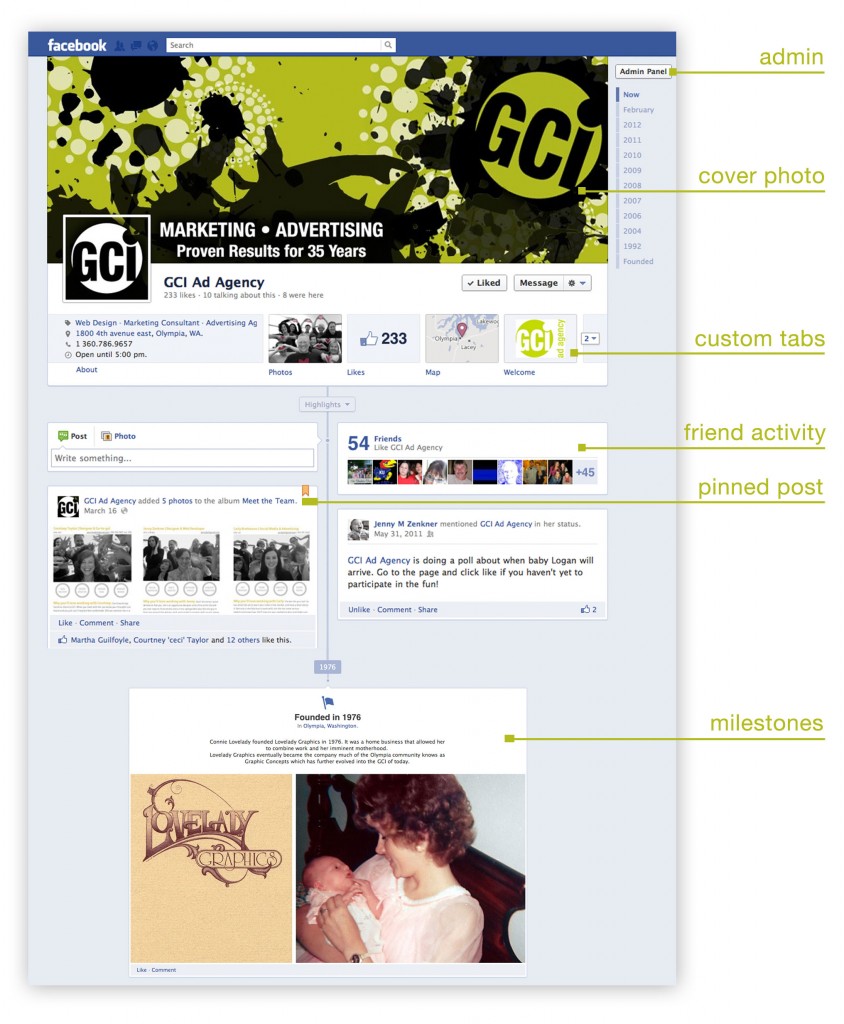New Timeline Layout Means Big Changes to Facebook Business Pages
All Facebook Business Pages are have a new Timeline layout, which means great new opportunities for your Page but just like when you first started Facebook, there is a learning curve.
Read on to find out all the ways you can use Facebook Business Pages, sharing and Facebook Campaigns to your advantage.
Wondering if fully setting up your Timeline is worth the effort?
Well, you can always call us!
The Timeline layout has new features such as:
- Cover Image – Where you can make an immediate impression by utilizing a large visual space.
- Milestones – You can show your company history and activity both chronologically and visually.
- Admin Panel – All you need to manage your Page in one easy convenient place.
- Custom Tab Changes – New location for custom tabs where once clicked on, the area is larger, but now you can’t have default landing anymore (this means no matter what, visitors to your page will land on the timeline itself).
- Pinned Posts – No longer do you have to keep reposting the same post to keep it at the top of your wall, with pinning your posts you can anchor the most important story to the top of your Page for up to 7 days.
- Star and Hide Stories – You can now choose to highlight or hide stories that aren’t as engaging or relevant to your fans.
- Friend Activity – Now your fans can see how their friends engage with your Page.
Does all of this sound great but you don’t have the time to learn or mess with your business Page Timeline? Let GCI do it for you! We have 3 convenient packages set up to match everybody’s budget & needs.
Your Online Repuation: Friend or Foe?
Online reputations can make or break a brand so we’ve put together this article to help you work out if you’re visible, if you have control over how people perceive your service and help guide your online customer interactions.
First off, do you have an online reputation? If you aren’t showing up, it’s like you don’t exist.
Traditionally, you should assume that people online won’t go past the first couple of pages of search results, and now we are hearing that unless someone is highly engaged, they aren’t likely to go past the first 3-5 results.
With this in mind, where do you stand? Do you find results about your company with simple searches like your name, company, brand, products, and industry + area.
If not, think of your online reputation as Non-Existent. It’s time to start building one!
Do you own your listings?
If you don’t control your brand online, someone else will.
Another issue with search results. Going back to the last topic, if you did the simple searches and results about you appear, but you don’t have control of the pages that show up, this is another issue. If you don’t claim ownership of listings from sites like Google Places and Yelp, then other people can update your information as they please. Not only will you be able to ensure more accuracy about your company by owning your listings, you will also be able to gain insights into how people find your online listings and be more aware of reviews people write about you.
This also applies to social media sites. Claim your name on Facebook, Linkedin, Twitter, etc. Someone else could have already or may soon take the name you would want to use and it can cause discrepancies in your branding strategies. In a worst case scenario, someone who is upset with you could register your name or be squatting on your name hoping to make you buy it from them.
Each of the sites mentioned above, and many others that may be appropriate places to list your business have guides on how to take control of your listings or profiles. Use their Help or FAQ sections.
If you don’t offer a positive opportunity for people to communicate with you, they can become discouraged and try to interact through less desirable channels.
Do you respond to feedback?
People expect accessibility online.
Now, assuming that you have taken control of your online presence, how do you manage it?
Positive Feedback:
Do you have positive reviews out there? Note the good things people are saying about you and keep them in mind as important aspects of your efforts moving forward. If people’s reviews say they appreciate your cheerful customer service, then taking on a snobby demeanor in your ads or other copywriting could estrange some of your most loyal customers.
Negative Feedback:
Are there negative reviews out there?
Own up to the reviews: If someone has a valid complaint, or if a group has similar or “me too!” complaints, do what you can to address the issue and make things right. People want to know that you care about their perception of you and that you take their concerns to heart.
Inaccurate reviews? Did someone say something like- you rescinded on an offer or your service didn’t work as promised, but the issue they are calling out doesn’t match your promotions or service descriptions? Politely let them know the facts. Perhaps they are mistaking you for someone else or didn’t review the terms of your service thoroughly.
Hateful but empty: Is someone saying something mean or angry with no real substance? If there is no real issue to address either let it go, or in the case of places like your Facebook wall, delete it. If you plan to do this, you should have a terms of use tab on your page outlining types of content that are not allowed, such as profane or hateful comments. Never delete a comment about a real issue! This will feel like you just hung up on a customer who called you with a concern. We’re sure you can imagine the negative word of mouth that follows this sort of action.
Do you have a strategy?
Be cognizant of the impact of anything you post online. Keep your marketing goals in mind and never say anything that conflicts with your brand image. This means you must do things like: avoid petty reactions to others, fact check your information, and include end dates on promotions that you don’t want to offer FOREVER. Mistakes in these areas can cost you dearly.
Are you being diligent?
It’s not enough to set things up, you need to monitor them. Make a routine effort to check on your listings, engage through social media, and read your reviews. There are tools to help with this: Google Alerts, Yahoo Alerts, Facebook Alerts and Insights, etc.
How To Lose A Customer In 10 Steps (Or Less!)
A What NOT To Do Guide
1) Take them for granted
Make sure not to take your customers for granted. Your customers are coming to you and giving you their business. It is important to treat them as individuals, value them, and show your genuine appreciation.
This can be as simple as including everyone involved in your e-mails, or sending them a thank you note.
Let’s run through some more…
2) Don’t Communicate
It can be easy to get caught up in what you are doing and let communication fall to the back burner, but if you think about how you would want to be treated, good communication becomes very important. This means many things:
- Give updates on the status of the work you are doing, whether it is a milestone or you run into an issue.
- If your customer prefers e-mail and you prefer the phone. Do your best to accommodate them. Little things like that are perfectly reasonable, try to be flexible.
- Don’t make assumptions about what your customer is thinking (you know what they say about assumptions). Ask for feedback!
- Your customers are individuals, not numbers, get to know them. If you are working with more than one person, include all of them as appropriate in your communications, and don’t belittle someone just because that aren’t your “key” contact.
3) Don’t Follow Etiquette
Be clear about costs up front and stay aware of the budget as you work.
Bill on time. Not unexpectedly or later than planned, your customers have a cash flow, and that must be respected. In the case of some agencies, if you miss the timeline for a bill, their hands are tied and they can’t pay you!
4) Talk Bigger Than You Walk
Never make promises you can’t keep. People have little patience for this and having a reputation for over-promising and under-delivering will follow you. Word of mouth is extremely powerful and unfortunately, the fastest way to get it is to do a bad job!
5) Forget Initiative
Never make your customers prod you to do your job! This means keeping your own schedule in check, and goes back to #2, keep your customer informed of your progress and any issues that may arise.
6) Be Flakey
If you schedule a meeting or service time, keep to that scheduled time! Don’t be late or unexpectedly early and don’t make a habit of canceling. This will quickly color a customer’s opinion of you and damage their faith in your competency.
7) Just Say “No”
If your customers are making reasonable requests, do whatever you can to say yes every time.
Move the deadline up 2 days because the customer had something come up? You padded your timeline from the beginning and this fits your schedule, “Yes.”
8) Never Say You’re Sorry
Always own up to mistakes. Be humble and do what you can to make things right.
Earlier we said that word of mouth is powerful. This is your opportunity to take a potentially bad situation and turn it into something good. People appreciate it when you do the right thing, and even if they are a bit unhappy about what happened, they will feel like they can trust you. Trust is invaluable.
9) Always Be The Boss
Yes, be the boss and be accountable and ensure quality from your staff, but remember the customer. When your customers foot the bill, treat them with the respect and authority they warrant; you answer to them.
10) Show Your Employees that You Don’t Care
It’s simple, when you treat your employees well, they will pass it on to your customers. Be sure to lead by example and offer training/guidance for your standards of customer service.
Back To School For All
Hey “big kids,” back to school season had us thinking… are you investing time in your continual learning?
To enhance your business it’s necessary to stay up to date on the latest technology, business principles, and marketing techniques. Fortunately for us, there are some great ways to continue our ongoing education without spending semesters on end in a classroom.
Here are a few of the ways to continue learning that we like best:
The Internet.
Why not take advantage of all of the resources online for enhancing our knowledge?? If nothing more, find a couple of good sites that write or post articles related to your industry and read them. (If you use twitter you can simply follow someone who posts articles of interest to you and they’ll pick good ones for you!)
Webinars.
Get a great presentation on a topic of interest without leaving the comforts of your home or office.
Entrepreneurs’ Groups.
Industry groups and leads groups can be great sources for presentations on current information and technology. There are other great local resources like Chambers and Economic Development Councils. They put on events that give great information.
Books.
This may feel like back to school on a more literal level, but there are fabulous industry related books out there. Odds are you’ll find some extremely useful books in the business or technology section of the bookstores here in town.
Online Groups.
Whether you find a group with related interests on a major site like facebook or linkedin, or you find a site dedicated to your industry, meeting up with like-minded people online simply breeds learning.
The Small Business Development Center.
Not only does the local small business development center offer great opportunities for learning (like short classes), if you are running a small business, they will help you make improvements to your business.
Publications.
Business publications, both local and national, are another great source for keeping up with the ever-changing face of business. Your continuing education should focus on all of the aspects of your business whether it is specific to the goods or services you offer, or to the issues involved in running a business today.
3 Tips To Avoid Getting Bad Sender Reputation
In this day and age when 90% of all emails are considered spam, how does one avoid being blacklisted? There are a few tips you can you can assure your emails land in your recipient’s inbox not in the dread Spam folder.
With services like Mailchimp (a free to use mass e-marketing tool) becoming ever more accessible and easy to use, we’ve put together some handy tips so that you can avoid spam filters and never end up with a bad sender reputation.
1. Monitor your levels of complaints, hard bounces and spam rates.
If you’re emailing in large volumes, it is critical that your complaint, hard bounce and spam rates remain low. A complaint occurs when a recipients hits the ‘report spam button’ at the end of the email. Your Internet Service Provider (ISP) will assume that you are a spammer based upon the amount of recipients hitting that button.
2. Don’t hesitate to pull any emails.
Hard bounces are the amount of emails that are being sent back to a sender. This can occur when you are emailing to unknown or non-existent email addresses.
3. Make sure your Internet Provider knows who you are.
You can authenticate your emails through Sender Policy Framework, Sender ID or Domain Keys. Just know that you should not rely on authentication alone, since spammers are known for also authenticating their IP addresses.
If you do find yourself with a bad reputation, no need to panic, it can be fixed. It’s just a matter of taking the time to assess your levels of complaints and making sure you are emailing to real addresses.
Here’s another freebie:
DON’T USE ALL CAPS OR EXCLAMATION POINTS IN THE SUBJECT LINE!!!
Seriously though – people actually do this, and it’s a sure fire way to have your email blocked before it even hits an inbox.
3 Good Reasons To Update Your Logo
Are you sick and tired of seeing your same old company logo staring back at you day after day?
Are you bored with the monotonous repetition of seeing it printed everywhere, on letterhead, online, on business cards, on shirts?
Is it always constant and ever present?
Well here’s the thing: boredom with your logo is not a good reason to update it.
In fact, consistency and repetition are actually good things for a brand. So, just because you’re tired of looking at it doesn’t mean your customers are over-exposed to it.
However, read on for three perfectly good reasons that a logo update may be in order for you.
You’re Outdated.
Your orange and brown may have been really popular colors when you first had the logo designed, but today, those colors are more reminiscent of your mom’s shag kitchen décor than the cutting edge company that you are. If you’re logo is outdated, a fresh look could bring renewed vibrancy and excitement to your brand.
You’ve Changed.
Well, maybe not you personally, but certainly if your company’s products, services, target market, or mission statement have changed. At its core, the logo should illustrate who you are as a company. Your logo serves as a first introduction to your company and it should leave a lasting impression.
You’re Moving.
Either literally or electronically. If you’re physically moving then it may be a good time to review your company branding. After all, you already have to print new letterhead, business cards, signage and other materials, why not review your brand while you’re at it?
If you are moving online, it can also be time to consider a logo update. Let’s say you’ve been a brick and mortar business, and you’ve decided to foray into the online world. How does your logo and branding translate to an online environment? Is it easy to recognize on a computer screen? Does it still represent the business?
Logo updates can have reinvigorating effects on customers and employees and can add a fresh vitality to your business.
Here’s how the Starbucks logo has evolved over the years:





